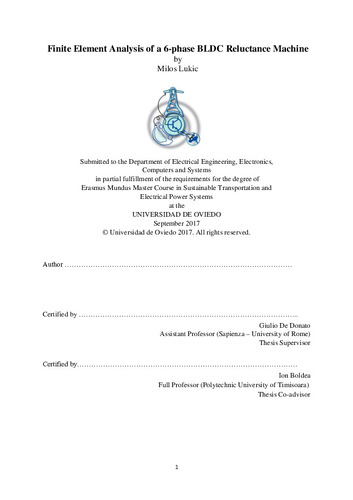Finite Element Analysis of a 6-phase BLDC Reluctance Machine
Autor(es) y otros:
Director(es):
Palabra(s) clave:
Multi-phase
BLDC
Reluctance
FEM
Fecha de publicación:
Serie:
Máster Universitario Erasmus Mundus en Transporte Sostenible y Sistemas Eléctricos de Potencia (EMMC STEPS)
Descripción física:
Resumen:
Multi-phase BLDC reluctance machines are a class of synchronous machines that was initially proposed in the eighties, although it didn’t receive much attention due to the concurrent success of high energy-product, rare-earth permanent magnet synchronous machines. Renewed attention has been drawn towards this class of machines very recently, due to the spike in the cost of rare-earth permanent magnets that occurred in 2011. Until now, only a few research groups have investigated BLDC reluctance machines, hence this thesis is intended as a contribution to a field of research which is covered by a limited amount of papers in the scientific literature. After an in-depth introduction, the thesis covers the preparation of the FEA model in MagNet 7. Matlab scripts have been developed to act as interfaces with MagNet to parametrise the model and to allow an easy exchange of the machine’s parameters and FEA results. Simulations are then reported, reporting torque and flux in various operating conditions, followed by the calculation of significant machine parameters such as inductances (apparent and incremental) and resistances. Moreover, the behaviour of the machine is investigated by applying various field and torque currents and by observing changes in the machine performances. Torque comparison between the model with non-linear and linear materials is also investigated for various field and torque currents. The effect of rotor skewing is demonstrated as a means of reducing torque ripple
Multi-phase BLDC reluctance machines are a class of synchronous machines that was initially proposed in the eighties, although it didn’t receive much attention due to the concurrent success of high energy-product, rare-earth permanent magnet synchronous machines. Renewed attention has been drawn towards this class of machines very recently, due to the spike in the cost of rare-earth permanent magnets that occurred in 2011. Until now, only a few research groups have investigated BLDC reluctance machines, hence this thesis is intended as a contribution to a field of research which is covered by a limited amount of papers in the scientific literature. After an in-depth introduction, the thesis covers the preparation of the FEA model in MagNet 7. Matlab scripts have been developed to act as interfaces with MagNet to parametrise the model and to allow an easy exchange of the machine’s parameters and FEA results. Simulations are then reported, reporting torque and flux in various operating conditions, followed by the calculation of significant machine parameters such as inductances (apparent and incremental) and resistances. Moreover, the behaviour of the machine is investigated by applying various field and torque currents and by observing changes in the machine performances. Torque comparison between the model with non-linear and linear materials is also investigated for various field and torque currents. The effect of rotor skewing is demonstrated as a means of reducing torque ripple
Colecciones
- Trabajos Fin de Máster [5255]
Ficheros en el ítem




